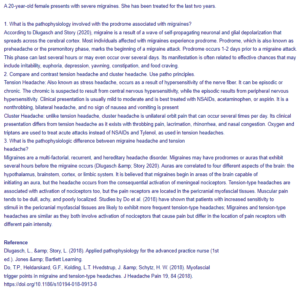Discussion Response – Headaches
Thank you for sharing your post. Headaches are very common symptoms. According to Turner et al. (2015), collectively, headache disorders are on the list of the most common disorders of the nervous system and affect persons of all ages, socio-economic statuses, and races. Headaches are also more commonly occurring in women than in men. Some headaches can be extremely debilitating and can significantly impact a person’s quality of life, impose high costs on the healthcare industry, and indirectly affect the general economy. It’s only a fraction of the headache disorders that call for the input of a specialist. Most headaches can be treated by a generalist or a primary care physician as long as the clinical diagnosis is accurate and requires no special investigation. The primary headache disorders that you have discussed in your post, migraine, cluster headache, and tension headaches, comprise nearly 98% of all headaches (Turner et al., 2015). Secondary headaches are also important to recognize as they may be life-threatening (Do et al., 2019). The most important aspect of diagnosing a secondary headache is taking the patient’s history. Most patients, including patients with secondary headaches, have no signs, and most times, investigations are not made to exclude a secondary headache. The most common secondary headaches include intracranial tumors that occupy space in the brain; CNS infection such as encephalitis or meningitis; cerebral venous thrombosis; giant-cell arteritis; idiopathic intracranial hypertension; and subarachnoid hemorrhage.
A patient with a secondary headache will have red flags and symptoms in their history, enabling a physician to make a diagnosis (Do et al., 2019). The common symptoms include headaches linked to postural changes, new headache onset in a cancer patient, new headache onset in an HIV+ patient, new headache onset in a patient that is above 50 years or below ten years of age, persistent morning headache that is characterized with nausea; a headache that progresses and worsens as the weeks go by; a thunderclap headache; and a headache with aura.
References
Do, T. P., Remmers, A., Schytz, H. W., Schankin, C., Nelson, S. E., Obermann, M., … & Schoonman, G. G. (2019). Red and orange flags for secondary headaches in clinical practice: SNNOOP10 list. Neurology, 92(3), 134-144.
Turner, D. P., Smitherman, T. A., Black, A. K., Penzien, D. B., Porter, J., Lofland, K. R., & Houle, T. T. (2015). Are migraine and tension-type headaches diagnostic types or points on a severity continuum? An exploration of the latent taxometric structure of headache. Pain, 156(7), 1200–1207. https://doi.org/10.1097/j.pain.0000000000000157
ORDER A PLAGIARISM-FREE PAPER HERE
We’ll write everything from scratch
Question
Discussion Response – Headaches
- -Length: A minimum of 200 words per post, not including references
- Citations: At least one high-level scholarly reference in APA per post from within the last 5 years
A 20-year-old female presents with severe migraines. She has been treated for the last two years.

Discussion Response – Headaches
1. What is the pathophysiology involved with the prodrome associated with migraines?
According to Dlugasch and Story (2020), migraine is a result of a wave of self-propagating neuronal and glial depolarization that spreads across the cerebral cortex. Most individuals affected with migraines experience prodrome. Prodrome, which is also known as preheadache or the premonitory phase, marks the beginning of a migraine attack. Prodrome occurs 1-2 days prior to a migraine attack. This phase can last several hours or may even occur over several days. Its manifestation is often related to effective chances that may include irritability, euphoria, depression, yawning, constipation, and food craving.
2. Compare and contrast tension headache and cluster headache. Use patho principles.
Tension Headache: Also known as stress headache, occurs as a result of hypersensitivity of the nerve fiber. It can be episodic or chronic. The chromic is suspected to result from central nervous hypersensitivity, while the episodic results from peripheral nervous hypersensitivity. Clinical presentation is usually mild to moderate and is best treated with NSAIDs, acetaminophen, or aspirin. It is a nonthrobbing, bilateral headache, and no sign of nausea and vomiting is present
Cluster Headache: unlike tension headache, cluster headache is unilateral orbital pain that can occur several times per day. Its clinical presentation differs from tension headache as it exists with throbbing pain, lacrimation, rhinorrhea, and nasal congestion. Oxygen and triptans are used to treat acute attacks instead of NSAIDs and Tylenol, as used in tension headaches.
3. What is the pathophysiologic difference between migraine headache and tension
headache?
Migraines are a multi-factorial, recurrent, and hereditary headache disorder. Migraines may have prodromes or auras that exhibit several hours before the migraine occurs (Dlugasch & Story 2020). Auras are correlated to four different aspects of the brain: the hypothalamus, brainstem, cortex, or limbic system. It is believed that migraines begin in areas of the brain capable of
initiating an aura, but the headache occurs from the consequential activation of meningeal nociceptors. Tension-type headaches are associated with activation of nociceptors too, but the pain receptors are located in the pericranial myofascial tissues. Muscular pain tends to be dull, achy, and poorly localized. Studies by Do et al. (2018) have shown that patients with increased sensitivity to
stimuli in the pericranial myofascial tissues are likely to exhibit more frequent tension-type headaches; Migraines and tension-type headaches are similar as they both involve activation of nociceptors that cause pain but differ in the location of pain receptors with different pain intensity.
Reference
Dlugasch, L., & Story, L. (2018). Applied pathophysiology for the advanced practice nurse (1st
ed.). Jones & Bartlett Learning.
Do, T.P., Heldarskard, G.F., Kolding, L.T. Hvedstrup, J. & Schytz, H. W. (2018). Myofascial
trigger points in migraine and tension-type headaches. J Headache Pain 19, 84 (2018).
https://doi.org/10.1186/s10194-018-0913-8

